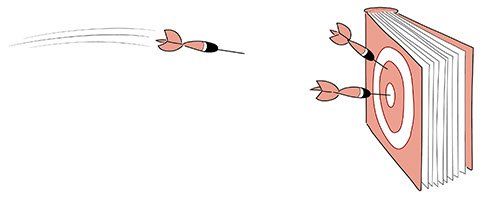Try this strategy before, during, or after
reading.
Using DARTS
Directed Activities Related to Text (DARTs) are a set of during-reading strategies designed to support reflective reading. Reflective reading (as opposed to merely receptive reading) happens when a reader breaks and re-reads challenging phrases and passages, really working at understanding. Reading with a specific purpose in mind and sharing ideas in small groups can help support reflective reading.
There are two broad categories of DARTs (reconstruction and analysis):
Reconstruction DARTs use unmodified texts.
Reconstruction DARTs are problem-solving activities that use modified text. The text has parts missing (words or phrases are deleted, or labels from a diagram). Alternatively, the text is broken into segments which are rearranged, leaving students to re-order them into the correct sequence. These are game-like DARTs, involving hunting for clues to complete the task. Students generally enjoy them and the results can feed into student writing about a topic. Here are several kinds of reconstruction DARTs:
- Completing text, diagram, or table
- Text completion. Students predict and complete deleted words, phrases, or sentences. (This is often referred to as a cloze procedure, and a text that has been modified for this activity is a cloze text; the term cloze derives from closure in Gestalt theory.)
- Diagram completion. Students predict and complete deleted labels and/or parts of diagrams using text and diagrams as sources of information.
- Table completion. Students use the text to complete a table using rows and columns provided by the teacher.
- Unscrambling and labeling
- Segmented and disordered text.
- Students predict logical order or time sequence of scrambled segments of text, e.g. a set of instructions.
- Students classify segments according to categories given by teacher.
Analysis DARTs use unmodified text
Analysis DARTs are about finding specific targets in unmodified texts. The teachers chooses “informations categories” for students to focus on in a text. Students locate and categorize information in the text, and underline or label the assigned targets when they find them. Here are several kinds of analysis DARTs:
- Marking and labeling
- Underlining/marking. Students search for specified targets in text, e.g. words or sentences, and mark them in some way.
- Labeling. Students label parts of the text, using labels provided for them.
- Segmenting. Students break the text down into segments, or units of information, and label these segments.
- Recording and constructing
- Constructing diagrams. Students construct diagrams to represent what the text is saying. They may use, for example, a flow diagram, a Venn diagram, or a branching tree.
- Table construction. Students construct and complete tables from information given in text, making up their own headings (rows and columns).
Using DARTs with the Seven Types of Text in Science
The seven common text types in science are instructional, classification, structure, mechanism, process, concept-principle and hypothesis-theory texts. Different DARTs are especially appropriate to the different text types.
Instructional Texts
For example, instructional texts usually explain how to carry out an experiment, assemble some apparatus, make something, or use a piece of equipment. The best activity directed to these texts might be one that calls on students to put scrambled instructional steps back into their proper order.
Classification Texts
A classification text might be, for example, a description of solids, liquids and gases—their differences and various properties. An underlining task would be appropriate here (where students underline the properties of each class), leading on to creating a table (listing the key features of the classes).
Structure Texts
A structure text is a piece of writing (accompanied by a diagram) about, say, the eye, a tooth, the Earth’s structure, roots, cells and so on. The text usually involves naming the parts, locating them, and perhaps identifying their function. Such text, with diagram, lends itself well to underlining, text completion, and annotation or labeling of the diagram.
Mechanism Texts
Mechanism texts explain how things work, e.g., the electric bell, the aneroid barometer, and (again) the human eye. Mechanism texts are similar to structure texts and lend themselves to the same activities as structure texts. Mechanism texts also often involve features of process texts.
Process Texts
Process texts describe how things are changed or transformed over a period of time, whether seconds or centuries. For example, a process text might describe how different kinds of rocks form, radioactive decay, the water cycle, digestion, or the life of a star. As with other text types, underlining and labeling are a good start. But the most valuable (and difficult) activity is for students to construct some kind of flow diagram or chart to summarize the main processes in the text.
Concept-principle and Hypothesis-theory Texts
Concept-principle texts and hypothesis-theory texts are similar to one another. They both involve fairly abstract accounts of how we try to make sense of the world. They might explain the nature of electric current, the kinetic theory of matter, or Newton’s laws. They could involve hypotheses about the origin of the universe, the beginning of life, or evolution. Reading activities for them could begin with the simple tasks of text completion or underlining. But eventually (especially with hypothesis-theory accounts), they should involve readers in the higher level tasks of evaluating a theory or model, or searching for evidence related to the theory.
Sample DARTs
- The Eye DART (cloze procedure; annotating diagram) - answer key
- The Meteor/Meteorite DART (cloze procedure; underlining text; constructing a summarizing table) - answer key
- Steam Turbine DART (jumbled sentences) - answer key
- Atom DART (constructing sentences) - answer key
- Solids, Liquids and Gases DART (underlining text; constructing a summarizing table) - answer key
